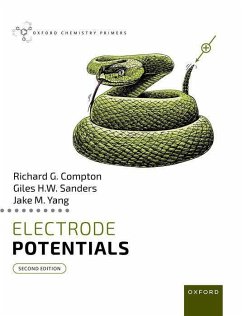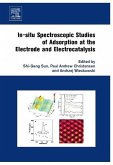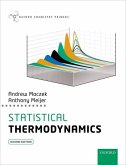Richard G. Compton (Oxford University), Giles H. W. Sanders (Head of Diagnostics ), Jake M. Yang (University of Leicester )
Electrode Potentials
Richard G. Compton (Oxford University), Giles H. W. Sanders (Head of Diagnostics ), Jake M. Yang (University of Leicester )
Electrode Potentials
- Broschiertes Buch
- Merkliste
- Auf die Merkliste
- Bewerten Bewerten
- Teilen
- Produkt teilen
- Produkterinnerung
- Produkterinnerung
Dealing with electrode potentials and their applications, this primer focuses on understanding the foundations of electrochemistry and how it can be applied to practical problems.
Andere Kunden interessierten sich auch für
![In-Situ Spectroscopic Studies of Adsorption at the Electrode and Electrocatalysis In-Situ Spectroscopic Studies of Adsorption at the Electrode and Electrocatalysis]() Shi-Gang Sun (ed.) / Paul A. Christensen / Andrzej WieckowskiIn-Situ Spectroscopic Studies of Adsorption at the Electrode and Electrocatalysis190,99 €
Shi-Gang Sun (ed.) / Paul A. Christensen / Andrzej WieckowskiIn-Situ Spectroscopic Studies of Adsorption at the Electrode and Electrocatalysis190,99 €![Statistical Thermodynamics Statistical Thermodynamics]() Andrew Maczek (Emeritus Professor, Emeritus Professor, University oStatistical Thermodynamics53,99 €
Andrew Maczek (Emeritus Professor, Emeritus Professor, University oStatistical Thermodynamics53,99 €![Atomically Dispersed Metallic Materials for Electrochemical Energy Technologies Atomically Dispersed Metallic Materials for Electrochemical Energy Technologies]() Atomically Dispersed Metallic Materials for Electrochemical Energy Technologies205,99 €
Atomically Dispersed Metallic Materials for Electrochemical Energy Technologies205,99 €![3D Printing 3D Printing]() 3D Printing261,99 €
3D Printing261,99 €![Micro to Quantum Supercapacitor Devices Micro to Quantum Supercapacitor Devices]() Abha Misra (Indian Institute of Science, Bangalore, India)Micro to Quantum Supercapacitor Devices113,99 €
Abha Misra (Indian Institute of Science, Bangalore, India)Micro to Quantum Supercapacitor Devices113,99 €![Ionic Liquids: From Fundamental Properties to Practical Applications Ionic Liquids: From Fundamental Properties to Practical Applications]() Ionic Liquids: From Fundamental Properties to Practical Applications228,99 €
Ionic Liquids: From Fundamental Properties to Practical Applications228,99 €![Metal-Air Batteries Metal-Air Batteries]() Metal-Air Batteries210,99 €
Metal-Air Batteries210,99 €-
-
-
Dealing with electrode potentials and their applications, this primer focuses on understanding the foundations of electrochemistry and how it can be applied to practical problems.
Produktdetails
- Produktdetails
- Oxford Chemistry Primers
- Verlag: Oxford University Press
- 2 Revised edition
- Seitenzahl: 152
- Erscheinungstermin: 20. Dezember 2024
- Englisch
- Abmessung: 242mm x 186mm x 10mm
- Gewicht: 312g
- ISBN-13: 9780198883579
- ISBN-10: 0198883579
- Artikelnr.: 70679982
- Herstellerkennzeichnung
- Libri GmbH
- Europaallee 1
- 36244 Bad Hersfeld
- gpsr@libri.de
- Oxford Chemistry Primers
- Verlag: Oxford University Press
- 2 Revised edition
- Seitenzahl: 152
- Erscheinungstermin: 20. Dezember 2024
- Englisch
- Abmessung: 242mm x 186mm x 10mm
- Gewicht: 312g
- ISBN-13: 9780198883579
- ISBN-10: 0198883579
- Artikelnr.: 70679982
- Herstellerkennzeichnung
- Libri GmbH
- Europaallee 1
- 36244 Bad Hersfeld
- gpsr@libri.de
Richard Compton was the Aldrichian Praelector and Professor in the Department of Chemistry, Oxford until 2023. He is now Emeritus Research Fellow at St John's College, Oxford and Visiting Chair of Electrochemistry at The Hong Kong Polytechnic University. He is a Fellow of the Royal Society of Chemistry, of IUPAC and of the International Society of Electrochemistry. He has published in excess of 1650 papers in the area of electrochemistry, as well as 7 books. Most notably he has co-authored: Understanding Voltammetry and the scientific biography, A G Stromberg - First Class Scientist, Second Class Citizen. Letters from the GULAG and a History of Electroanalysis in the USSR. Giles Sanders is the Head of Diagnostics at TTP Plc, a Cambridge based technology innovation and product development company. Since the publication of the first edition of Electrode Potentials in 1996, Giles has continued to apply learnings from his Degree and DPhil studies at Oxford (the latter under the supervision of Richard Compton) to help companies develop new innovative products and technology in discovery chemistry, sensors and diagnostics. Jake (formal name Minjun) Yang received his MChem and DPhil from the University of Oxford. After Jake's DPhil viva in 2020, he received an EPSRC Doctoral Prize Award to develop electrochemical sensors to monitor 'blue carbon' sequestered by the Ocean. His research concerns how electrons interact with molecules and ions and how one might use this to strategically probe the world around us. Jake was appointed lecturer of Physical Chemistry at the University of Leicester in 2023 where he is leading research and undergraduate teaching.
1: Getting started
2: Allowing for non-ideality: activity coefficients
3: Ions in motion
4: Going further
5: Further applications: Chemical Sensing and Energy Transformation
6: Worked examples and problems
2: Allowing for non-ideality: activity coefficients
3: Ions in motion
4: Going further
5: Further applications: Chemical Sensing and Energy Transformation
6: Worked examples and problems
1: Getting started
2: Allowing for non-ideality: activity coefficients
3: Ions in motion
4: Going further
5: Further applications: Chemical Sensing and Energy Transformation
6: Worked examples and problems
2: Allowing for non-ideality: activity coefficients
3: Ions in motion
4: Going further
5: Further applications: Chemical Sensing and Energy Transformation
6: Worked examples and problems








